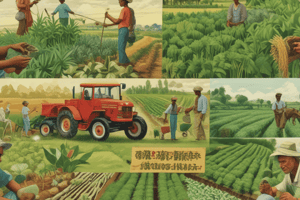Podcast
Questions and Answers
What is one of the problems faced in agriculture marketing that contributes to the need for import substitution?
What is one of the problems faced in agriculture marketing that contributes to the need for import substitution?
- Shortage of raw material
- Competition from large scale industries (correct)
- Outdated machines
- Underutilised export potential
Why was the import substitution policy important according to the text?
Why was the import substitution policy important according to the text?
- To promote underutilised export potential
- To protect industries under state control from competition (correct)
- To overcome the shortage of raw materials
- To encourage the use of high yielding varieties of seeds
What was a key role played by the private sector in the import substitution policy mentioned in the text?
What was a key role played by the private sector in the import substitution policy mentioned in the text?
- Imposing bureaucratic hurdles
- Competing against large scale industries
- Being the sole responsibility for import substitution
- Obtaining licenses for imports (correct)
Which factor influenced India's decision to limit the imports of goods during 1950-90 according to the text?
Which factor influenced India's decision to limit the imports of goods during 1950-90 according to the text?
What was one common objective of the inward-looking trade policy mentioned in the text?
What was one common objective of the inward-looking trade policy mentioned in the text?
Why were domestic producers required to obtain licenses for imports in the context of the import substitution policy?
Why were domestic producers required to obtain licenses for imports in the context of the import substitution policy?
What is the formula for Marketable Surplus as mentioned in the text?
What is the formula for Marketable Surplus as mentioned in the text?
What is one of the drawbacks mentioned for the Green Revolution in relation to food production?
What is one of the drawbacks mentioned for the Green Revolution in relation to food production?
Why are subsidies in agriculture considered important, according to the text?
Why are subsidies in agriculture considered important, according to the text?
Which aspect of Industry is highlighted as a benefit in relation to agriculture?
Which aspect of Industry is highlighted as a benefit in relation to agriculture?
What is the outcome of eliminating subsidies in agriculture?
What is the outcome of eliminating subsidies in agriculture?
What was the basic element of the 'High-Yielding Varieties programme' (HYVP) introduced during the Green Revolution?
What was the basic element of the 'High-Yielding Varieties programme' (HYVP) introduced during the Green Revolution?
What was a key feature of the Green Revolution in India?
What was a key feature of the Green Revolution in India?
What was a major impact of the Green Revolution in India?
What was a major impact of the Green Revolution in India?
Which agricultural practice was NOT a part of the Green Revolution in India?
Which agricultural practice was NOT a part of the Green Revolution in India?
What was one technological innovation commonly used during the Green Revolution?
What was one technological innovation commonly used during the Green Revolution?
What was a critical aspect of the New Agricultural Strategy implemented during the Green Revolution?
What was a critical aspect of the New Agricultural Strategy implemented during the Green Revolution?
Study Notes
Importance of Irrigation and Pesticide
- Adequate irrigation facilities and use of pesticide are essential for agricultural growth.
Effects of Green Revolution
- Marketable surplus = Total production - Self consumption
- Supply in favour of subsidies
- Drawbacks of food: confined to limited area of the country, limited coverage, and inequality among farmers, with big farmers receiving greater benefits.
Importance of Industry
- Employment generation
- Development of agriculture
- Exploitation of resources
- Productivity
- High potential for high volume of exports, leading to growth
- Key to self-sustaining development of regional balances
Subsidies
- Subsidies do not benefit most farmers in India, who are poor and cannot afford required inputs without subsidies.
- Elimination of subsidies will increase inequality between rich and poor farmers.
- Against subsidies: the purpose of subsidies is not being served, and it should be phased out.
Classification of Industries
- Public sector (state-owned units)
- Private sector (Schedule B)
- Joint sector (Schedule C)
Promotion of Industry
- Improvement in agriculture marketing
- Reasons for import substitution: problems, shortage of raw material, difficulties in marketing, outdated machines, underutilized export potential, bureaucratic hurdles, and competition from large-scale industries.
Import Substitution Policy
- Policy for a large part of the period 1950-90
- Import substitution only benefits farmers in a limited way
- Imposing tariffs on imported goods to protect domestic producers
Problems of Indian Agriculture
- Institutional problems: defective land reforms, lack of credit, population pressure on land, availability of land, subsistence farming, marketing facilities, land degradation, and size of land holdings.
- General problems: social problems, pressure on land, and crop losses.
Agrarian Reforms
- Abolition of intermediaries
- Regulations on rent
- Land ceiling
- Extensive use of fertilizers
- Use of pesticides
Phases of Green Revolution
- First phase: mid-1960s to mid-1970s
- Second phase: mid-1970s to mid-1980s
- Features of Green Revolution: attaining marketable surplus, buffer stock of food grains, benefits to low-income groups, cooperative farming, agricultural mechanization, price support policy, and irrigation.
New Agricultural Strategy
- High-Yielding Varieties programme (HYVP)
- Package programme introduced in the kharif season of mid-1960s
- Use of HYVS facilities, high-yielding varieties of seeds, chemical fertilizers, and irrigation.
Studying That Suits You
Use AI to generate personalized quizzes and flashcards to suit your learning preferences.
Description
Test your knowledge on the effects of Green Revolution, like marketable surplus and drawbacks, as well as the importance of the industry in areas such as employment generation, agriculture development, and resource exploitation.





